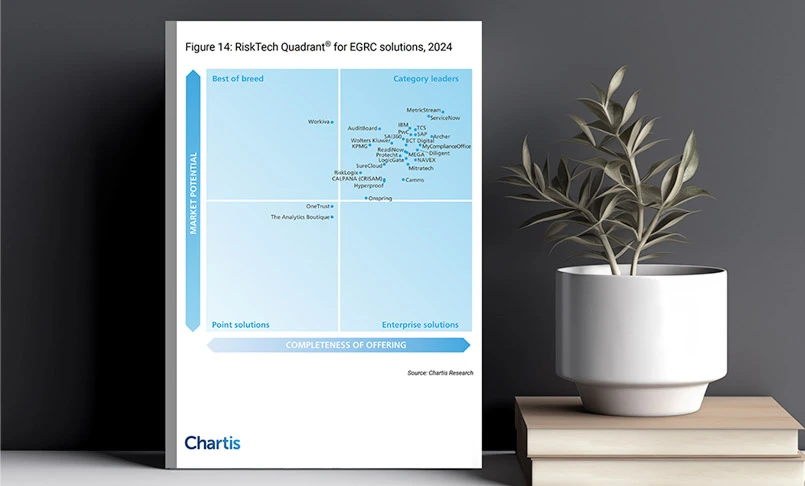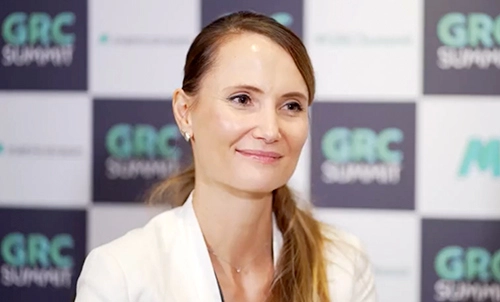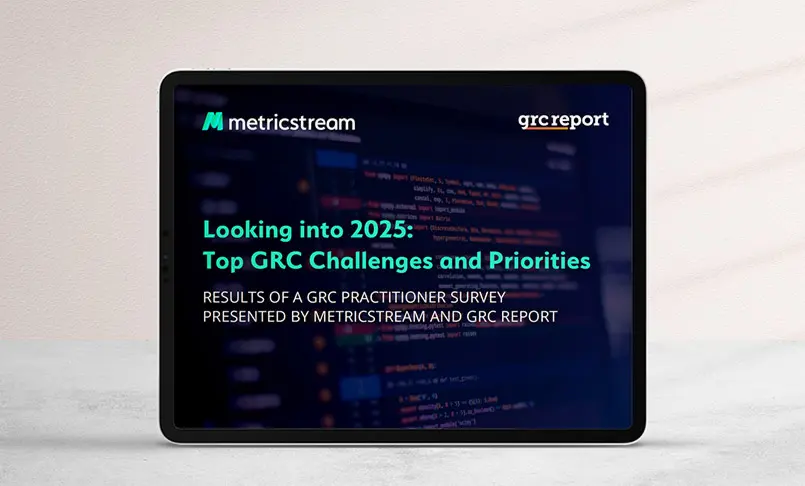Introduction
Working towards a high level of compliance maturity is crucial for organizations that want to minimize risk, enhance operational efficiency, and build a resilient reputation. However, achieving compliance maturity can be quite challenging - from managing evolving regulatory landscapes to fostering employee engagement, companies must navigate various obstacles to develop a compliance program that’s both effective and sustainable.
In this article, we’ll explore what a compliance maturity model entails, how it can benefit an organization, the key challenges they face, and the steps involved in developing a comprehensive strategy to overcome them.
Key Takeaways
- The compliance maturity model is a framework used by organizations to assess and improve their compliance processes and culture.
- It helps evaluate the effectiveness of their compliance policies, procedures, governance, technology, training, and risk management.
- It is crucial for organizations looking to create a structured approach to understanding and improving their compliance programs.
- There are many challenges to overcome, but by implementing best practices, organizations can create a resilient and adaptable compliance program that meets regulatory requirements and strengthens the organization’s strategic position.
What is the Compliance Maturity Model?
The compliance maturity model is a framework used by organizations to assess and improve their compliance processes and culture. It helps evaluate their level of compliance effectiveness across policies, procedures, governance, technology, training, and risk management.
By using a compliance maturity model, organizations can assess and benchmark their current levels of compliance against industry standards. This also means that they are likely to have fewer compliance risks while also identifying areas for improvement in their compliance efforts.
A compliance maturity model is used to earmark investments in compliance processes, personnel, and technology, gradually working towards more optimized compliance.
Importance of a Compliance Maturity Model
The compliance maturity model is crucial for organizations seeking a structured approach to understanding and improving their compliance programs. Here are some of the ways that it can be beneficial:
- Mitigation of risk and reduction of regulatory penalties: Organizations can identify weaknesses in their compliance programs and strengthen their defenses.
- Structured growth and improvement: The model provides a roadmap for building a robust compliance program over time, allowing organizations to grow in a structured way.
- Enhanced efficiency and resource allocation: As compliance activities become more streamlined, resources can be allocated more effectively, reducing costs and minimizing repetitive tasks.
- Improved stakeholder confidence and trust: A mature compliance program fosters trust among stakeholders and demonstrates that the organization takes compliance seriously.
- Stronger organizational culture and employee accountability: Mature compliance processes help employees at all levels understand their roles in upholding compliance standards.
- Informed decision-making and proactive management: Advanced compliance programs rely on data to make informed decisions, which helps predict potential compliance issues and respond proactively.
- Alignment with strategic objectives: When compliance becomes an integrated aspect of operations, it aligns more closely with organizational goals. It then contributes to overall business strategy.
- Competitive advantage: Organizations with mature compliance programs are often better positioned to adapt to regulatory changes.
Stages of a Compliance Maturity Model
Here’s a breakdown of the typical stages in this model:
- Ad hoc (Initial): In this stage, compliance efforts are minimal or reactive. The organization responds to issues as they arise but needs formal policies, structured processes, or proactive risk management.
- Repeatable (Basic): At this level, the organization has some compliance processes in place, but they are inconsistent or informal. Compliance is mostly driven by individual efforts and not a structured program.
- Defined (Standardized): Here, compliance processes are documented, standardized, and shared across the organization. The company begins to implement formal governance and accountability structures.
- Managed (Proactive): At this stage, compliance is integrated into the company’s culture and operations. The organization uses data to proactively manage and anticipate compliance risks, with well-defined roles and responsibilities.
- Optimized (Leading): At the final stage, compliance is deeply embedded in the organization’s processes, culture, and strategy. Compliance management is dynamic, leveraging advanced tools and insights to continuously improve.
Key Challenges in the Compliance Maturity Stage
Reaching and sustaining a high level in the compliance maturity stage presents several key challenges. These difficulties are often due to the complexity of regulatory requirements, resource limitations, and the need for ongoing improvement. Here are the main challenges organizations face at various stages:
| Challenge | Description | Potential Solution |
|---|---|---|
| Resource constraints | Limited budgets and resources make it challenging to support comprehensive compliance initiatives. | Prioritize high-impact initiatives and justify compliance as part of risk management and value protection. |
| Complex and changing regulatory environment | Constant regulatory changes require dedicated resources to stay updated and adapt compliance practices. | Establish a dedicated compliance team or partner with external experts for up-to-date regulatory insights. |
| Data management and integration | Difficulty in consolidating and integrating data across systems leads to inconsistencies and inefficiencies. | Use integrated compliance management software to ensure consistency and improve data-driven decision-making. |
| Cultural buy-in and employee engagement | Employees may view compliance as a burden, impacting engagement and accountability. | Regular training, transparent communication, and leadership commitment to foster a culture of accountability. |
| Balancing compliance with business objectives | Compliance may be seen as restrictive, especially in high-growth environments. | Position compliance as a risk mitigation strategy that supports sustainable growth and enhances reputation. |
| Measuring and demonstrating compliance ROI | Difficulty in quantifying compliance ROI can hinder investment. | Focus on metrics like incident reduction, fines averted, and operational efficiencies to demonstrate ROI. |
| Technological challenges and lack of automation | Limited automation or outdated systems make scaling compliance difficult. | Gradually invest in scalable technology solutions that support automation and advanced monitoring. |
| Maintaining momentum and continuous improvement | Sustaining high compliance standards over time requires focus and resources. | Implement regular audits and continuous improvement processes to adapt and refine compliance efforts. |
| Global and cross-jurisdictional compliance | Operating in multiple regions with varying regulations adds complexity. | Develop a centralized framework that can adapt to different jurisdictions, ensuring global consistency. |
How to Build a Compliance Maturity Model for Your Organization?
Building a compliance maturity model for your organization involves assessing your current compliance practices, setting realistic goals, and creating a structured plan for continuous improvement. Here’s a step-by-step guide to developing one:
- Assess the current compliance landscape: Start by analyzing to identify gaps between your current state and desired maturity level, before moving on to reviewing specific regulatory requirements for your industry and region. Then, engage various stakeholders to help understand your compliance needs.
- Define maturity levels and criteria: Establish the stages you want to include in your model, describe the characteristics of each stage, and define specific criteria for each stage in various relevant areas.
- Identify key compliance areas: Identify core areas essential to your organization’s compliance efforts, then assess which compliance areas carry the most risk or regulatory scrutiny and focus initial efforts on strengthening these areas.
- Develop compliance policies and procedures: Establish formal, documented policies and procedures and then create standardized procedures for handling compliance-related tasks.
- Implement technology and tools for automation: Depending on your organization’s size and needs, consider tools for compliance tracking, monitoring, reporting, and data integration. Use these to automate routine compliance tasks.
- Build a governance and accountability structure: Clarify roles for compliance oversight, including a compliance officer or team. Larger organizations will benefit from a compliance committee.
- Create a training and awareness program: Develop training programs tailored to different departments and roles. Encourage a compliance-minded culture by regularly communicating the importance of compliance to all employees.
- Implement regular monitoring and auditing: Perform regular audits to review compliance, identify gaps, and make adjustments. Implement real-time monitoring tools to detect potential issues. Track KPIs to measure compliance effectiveness and maturity progress.
- Evaluate and improve continuously: Use audit findings, risk assessments, and employee feedback to make continuous improvements. Keep up with evolving regulations and update policies and practices accordingly. Regularly assess progress against your maturity criteria and set goals for moving to the next level.
- Report and communicate progress to stakeholders: Create standardized compliance reports for key stakeholders, while also recognizing and rewarding progress towards compliance maturity milestones.
Conclusion
While the path to compliance maturity can be complex, the benefits of a well-established and proactive compliance program are undeniable. MetricStream’s Compliance Management addresses common challenges thus enabling organizations to transform compliance from a regulatory requirement into strategic advantage.
A compliance maturity model is not static; it should evolve as the organization grows and as regulations change. By systematically building and advancing compliance maturity, organizations can strengthen their resilience, protect their reputation, and create a culture of compliance that supports long-term success.
Frequently Asked Questions
What are the 5 levels of maturity Modelling?
The 5 stages or levels of compliance maturity modeling are: Ad hoc (Initial), Repeatable (Basic), Defined (Standardized), Managed (Proactive) and Optimized (Leading).
What are examples of compliance maturity models?
Some widely recognized compliance maturity models are:
- Capability Maturity Model Integration (CMMI)
- NIST Cybersecurity Framework (CSF)
- COSO Framework for Internal Control and Compliance
- Data Protection Maturity Model (DPMM)
- ISO 19600/ISO 37301 Compliance Management Maturity Model
- FFIEC Cybersecurity Maturity Model
- Compliance and Ethics Maturity Model
- HIPAA Security Compliance Maturity Model
- Open Compliance and Ethics Group (OCEG) Capability Maturity Model
These models are commonly used across different industries to assess and improve organizational compliance practices.
Working towards a high level of compliance maturity is crucial for organizations that want to minimize risk, enhance operational efficiency, and build a resilient reputation. However, achieving compliance maturity can be quite challenging - from managing evolving regulatory landscapes to fostering employee engagement, companies must navigate various obstacles to develop a compliance program that’s both effective and sustainable.
In this article, we’ll explore what a compliance maturity model entails, how it can benefit an organization, the key challenges they face, and the steps involved in developing a comprehensive strategy to overcome them.
- The compliance maturity model is a framework used by organizations to assess and improve their compliance processes and culture.
- It helps evaluate the effectiveness of their compliance policies, procedures, governance, technology, training, and risk management.
- It is crucial for organizations looking to create a structured approach to understanding and improving their compliance programs.
- There are many challenges to overcome, but by implementing best practices, organizations can create a resilient and adaptable compliance program that meets regulatory requirements and strengthens the organization’s strategic position.
The compliance maturity model is a framework used by organizations to assess and improve their compliance processes and culture. It helps evaluate their level of compliance effectiveness across policies, procedures, governance, technology, training, and risk management.
By using a compliance maturity model, organizations can assess and benchmark their current levels of compliance against industry standards. This also means that they are likely to have fewer compliance risks while also identifying areas for improvement in their compliance efforts.
A compliance maturity model is used to earmark investments in compliance processes, personnel, and technology, gradually working towards more optimized compliance.
The compliance maturity model is crucial for organizations seeking a structured approach to understanding and improving their compliance programs. Here are some of the ways that it can be beneficial:
- Mitigation of risk and reduction of regulatory penalties: Organizations can identify weaknesses in their compliance programs and strengthen their defenses.
- Structured growth and improvement: The model provides a roadmap for building a robust compliance program over time, allowing organizations to grow in a structured way.
- Enhanced efficiency and resource allocation: As compliance activities become more streamlined, resources can be allocated more effectively, reducing costs and minimizing repetitive tasks.
- Improved stakeholder confidence and trust: A mature compliance program fosters trust among stakeholders and demonstrates that the organization takes compliance seriously.
- Stronger organizational culture and employee accountability: Mature compliance processes help employees at all levels understand their roles in upholding compliance standards.
- Informed decision-making and proactive management: Advanced compliance programs rely on data to make informed decisions, which helps predict potential compliance issues and respond proactively.
- Alignment with strategic objectives: When compliance becomes an integrated aspect of operations, it aligns more closely with organizational goals. It then contributes to overall business strategy.
- Competitive advantage: Organizations with mature compliance programs are often better positioned to adapt to regulatory changes.
Here’s a breakdown of the typical stages in this model:
- Ad hoc (Initial): In this stage, compliance efforts are minimal or reactive. The organization responds to issues as they arise but needs formal policies, structured processes, or proactive risk management.
- Repeatable (Basic): At this level, the organization has some compliance processes in place, but they are inconsistent or informal. Compliance is mostly driven by individual efforts and not a structured program.
- Defined (Standardized): Here, compliance processes are documented, standardized, and shared across the organization. The company begins to implement formal governance and accountability structures.
- Managed (Proactive): At this stage, compliance is integrated into the company’s culture and operations. The organization uses data to proactively manage and anticipate compliance risks, with well-defined roles and responsibilities.
- Optimized (Leading): At the final stage, compliance is deeply embedded in the organization’s processes, culture, and strategy. Compliance management is dynamic, leveraging advanced tools and insights to continuously improve.
Reaching and sustaining a high level in the compliance maturity stage presents several key challenges. These difficulties are often due to the complexity of regulatory requirements, resource limitations, and the need for ongoing improvement. Here are the main challenges organizations face at various stages:
| Challenge | Description | Potential Solution |
|---|---|---|
| Resource constraints | Limited budgets and resources make it challenging to support comprehensive compliance initiatives. | Prioritize high-impact initiatives and justify compliance as part of risk management and value protection. |
| Complex and changing regulatory environment | Constant regulatory changes require dedicated resources to stay updated and adapt compliance practices. | Establish a dedicated compliance team or partner with external experts for up-to-date regulatory insights. |
| Data management and integration | Difficulty in consolidating and integrating data across systems leads to inconsistencies and inefficiencies. | Use integrated compliance management software to ensure consistency and improve data-driven decision-making. |
| Cultural buy-in and employee engagement | Employees may view compliance as a burden, impacting engagement and accountability. | Regular training, transparent communication, and leadership commitment to foster a culture of accountability. |
| Balancing compliance with business objectives | Compliance may be seen as restrictive, especially in high-growth environments. | Position compliance as a risk mitigation strategy that supports sustainable growth and enhances reputation. |
| Measuring and demonstrating compliance ROI | Difficulty in quantifying compliance ROI can hinder investment. | Focus on metrics like incident reduction, fines averted, and operational efficiencies to demonstrate ROI. |
| Technological challenges and lack of automation | Limited automation or outdated systems make scaling compliance difficult. | Gradually invest in scalable technology solutions that support automation and advanced monitoring. |
| Maintaining momentum and continuous improvement | Sustaining high compliance standards over time requires focus and resources. | Implement regular audits and continuous improvement processes to adapt and refine compliance efforts. |
| Global and cross-jurisdictional compliance | Operating in multiple regions with varying regulations adds complexity. | Develop a centralized framework that can adapt to different jurisdictions, ensuring global consistency. |
Building a compliance maturity model for your organization involves assessing your current compliance practices, setting realistic goals, and creating a structured plan for continuous improvement. Here’s a step-by-step guide to developing one:
- Assess the current compliance landscape: Start by analyzing to identify gaps between your current state and desired maturity level, before moving on to reviewing specific regulatory requirements for your industry and region. Then, engage various stakeholders to help understand your compliance needs.
- Define maturity levels and criteria: Establish the stages you want to include in your model, describe the characteristics of each stage, and define specific criteria for each stage in various relevant areas.
- Identify key compliance areas: Identify core areas essential to your organization’s compliance efforts, then assess which compliance areas carry the most risk or regulatory scrutiny and focus initial efforts on strengthening these areas.
- Develop compliance policies and procedures: Establish formal, documented policies and procedures and then create standardized procedures for handling compliance-related tasks.
- Implement technology and tools for automation: Depending on your organization’s size and needs, consider tools for compliance tracking, monitoring, reporting, and data integration. Use these to automate routine compliance tasks.
- Build a governance and accountability structure: Clarify roles for compliance oversight, including a compliance officer or team. Larger organizations will benefit from a compliance committee.
- Create a training and awareness program: Develop training programs tailored to different departments and roles. Encourage a compliance-minded culture by regularly communicating the importance of compliance to all employees.
- Implement regular monitoring and auditing: Perform regular audits to review compliance, identify gaps, and make adjustments. Implement real-time monitoring tools to detect potential issues. Track KPIs to measure compliance effectiveness and maturity progress.
- Evaluate and improve continuously: Use audit findings, risk assessments, and employee feedback to make continuous improvements. Keep up with evolving regulations and update policies and practices accordingly. Regularly assess progress against your maturity criteria and set goals for moving to the next level.
- Report and communicate progress to stakeholders: Create standardized compliance reports for key stakeholders, while also recognizing and rewarding progress towards compliance maturity milestones.
While the path to compliance maturity can be complex, the benefits of a well-established and proactive compliance program are undeniable. MetricStream’s Compliance Management addresses common challenges thus enabling organizations to transform compliance from a regulatory requirement into strategic advantage.
A compliance maturity model is not static; it should evolve as the organization grows and as regulations change. By systematically building and advancing compliance maturity, organizations can strengthen their resilience, protect their reputation, and create a culture of compliance that supports long-term success.
What are the 5 levels of maturity Modelling?
The 5 stages or levels of compliance maturity modeling are: Ad hoc (Initial), Repeatable (Basic), Defined (Standardized), Managed (Proactive) and Optimized (Leading).
What are examples of compliance maturity models?
Some widely recognized compliance maturity models are:
- Capability Maturity Model Integration (CMMI)
- NIST Cybersecurity Framework (CSF)
- COSO Framework for Internal Control and Compliance
- Data Protection Maturity Model (DPMM)
- ISO 19600/ISO 37301 Compliance Management Maturity Model
- FFIEC Cybersecurity Maturity Model
- Compliance and Ethics Maturity Model
- HIPAA Security Compliance Maturity Model
- Open Compliance and Ethics Group (OCEG) Capability Maturity Model
These models are commonly used across different industries to assess and improve organizational compliance practices.








